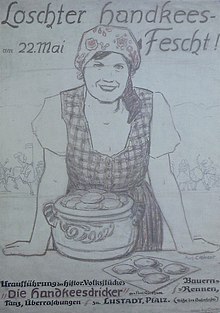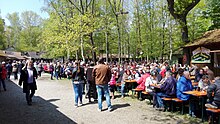Losender Handkeesfescht
The Loschter Handkeesfescht is a folk festival founded in 1925 that takes place around May 1st every year in the May flower forest near Lustadt .
history
After Lustadt - separated into the towns of Ober- and Niederlustadt until 1969 - in 1785 in connection with a centuries-long legal dispute with the city of Germersheim over the so-called existing forest in the Bellheimer Wald , which was only finally settled in 1869, was exempted from market and stall money in Germersheim , the Lustadter specialized in the production of hand cheese . Over time, they were given the name Handkeesdricker , which they adopted for themselves.

The brick factory owner and 2nd chairman of the Lustadter local group of the Palatinate Forest Association Georg Lehr received an invitation in 1924 to the Palatinate-Alemannic Heimattag in Karlsruhe. Under his leadership, the local group took part there with a float under the motto Loschter Handkeesdrikker . After a return visit by Fritz Riederer from Karlsruhe in a private setting, the idea arose to reinforce the friendship between the PWV local groups Lustadt and Karlsruhe as part of a folk festival. The announced “folk festival, combined with a big cheese meal” finally became the first Loschter Handkeesfescht , which was held on May 3, 1925 and was organized by Georg Lehr and Georg Ott - Niederlustadter mayor and 1st chairman of the Palatinate Forest Association. The festival took place annually on a Sunday in May in the May flower forest south of Lustadt and quickly established itself in the series of the larger Palatinate folk festivals. The focus was always on the sale and consumption of "hand cheese, butter, bread". Lehr and Ott († 1927) expanded the festival steadily. In 1927, the stage play Die Handkeesdricker by Paul Ginthum , which was directed by Heiner from Bellem, premiered at the festival .
After the festival was suspended from 1931 to 1933, it was resumed from 1934 to 1939 and partly influenced by the Nazi regime; So the festival was held at the behest of the Gauleiter Josef Bürckel in 1936 on the gymnastics area instead of in the May flower forest and officially organized in 1938 by the Nazi community Kraft durch Freude. The festival did not take place during World War II.
In 1949 the first Handkeesfescht took place after the war. The initiative came from the founder Georg Lehr, who, as chairman of the festival committee, took over the main responsibility again until 1958. After obtaining the necessary approval from the French occupation, the festival could take place on May 8, 1949. Due to management regulations, no hand cheese could be produced this year. The rush of visitors was there again immediately (8000), so that even the seats ran out and many people “picnicked” on the floor.
In 1950 the Handkeesfescht had its 25th anniversary and hand cheese was sold again. The number of visitors grew rapidly in these years, with 15,000 visitors already counted in 1952. This was also due to the fact that the festival was extended into the evening hours (1950) and above all with the extension to three festive days (1951; later four). In 1950 the first permanent building was also erected on Handkeesplatz ("Onkel-Schorsch-Hütte").
In the 1960s to 1990s, the infrastructure on Handkeesplatz was gradually expanded, which is also used for various other events all year round. In 1970 the Loschter Handkeesfescht association was entered in the association register. The number of visitors currently amounts to around 40,000 per year.
literature
- Loschter Handkeesfescht e. V. (Ed.) / Brigitte Ansorge: Die Loschter Handkeesdricker , 1998.
- Loschter Handkeesfescht e. V. (Ed.) / Brigitte Ansorge: 75 years of Loschter Handkeesfescht , 2000.
Notes and individual references
- ↑ Quote from a letter of invitation, cf. Ansorge 2000, p. 39
- ^ Parole in various advertisements for the festival, cf. z. B. Ansorge 2000, pp. 101 and 308
- ↑ Leisure magazine LEO: Volkstümliche spicy delights, Ludwigshafen, April 30, 2009
Coordinates: 49 ° 13 ′ 44.4 " N , 8 ° 16 ′ 35.7" E

